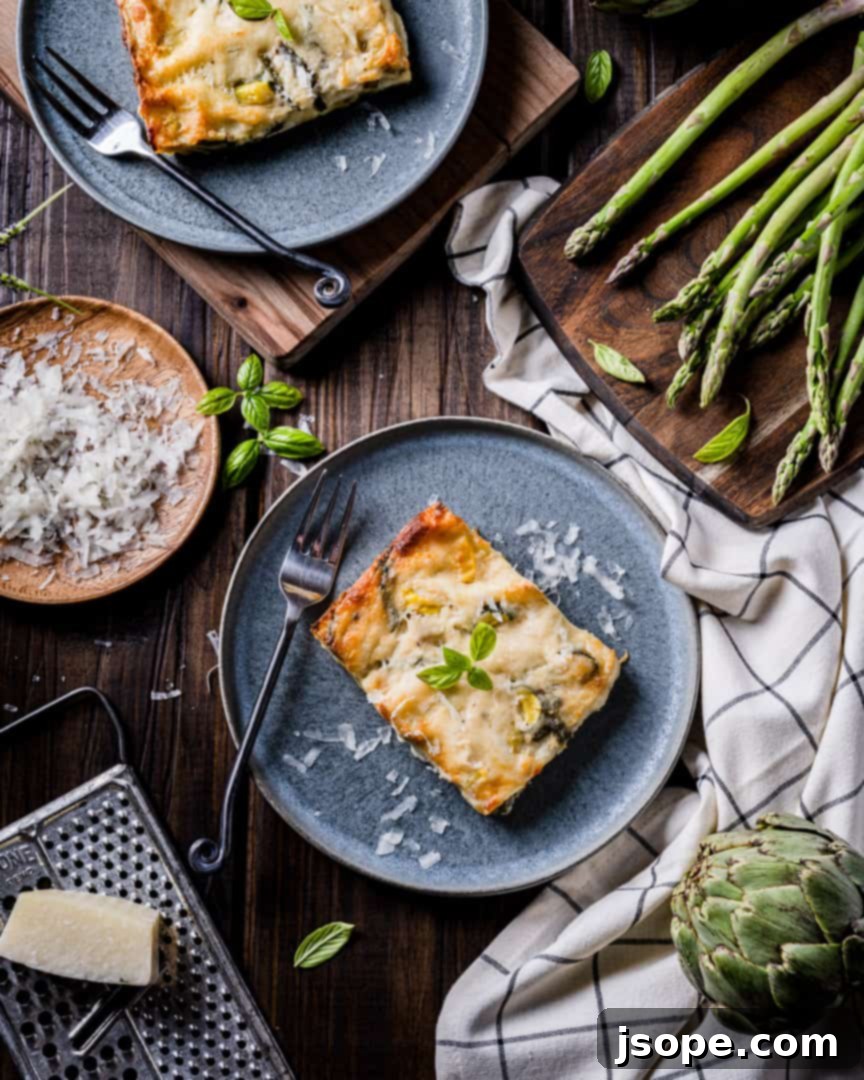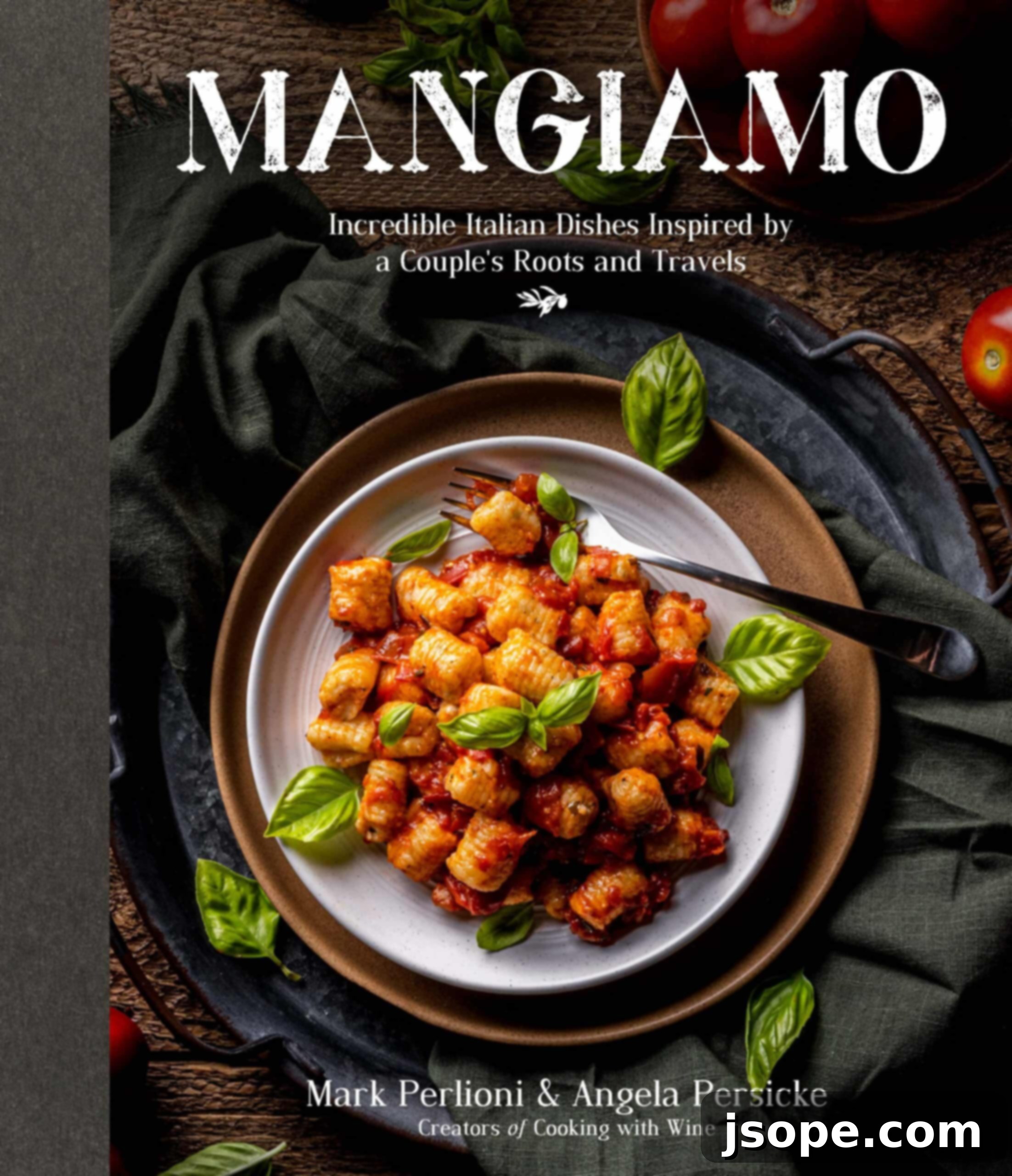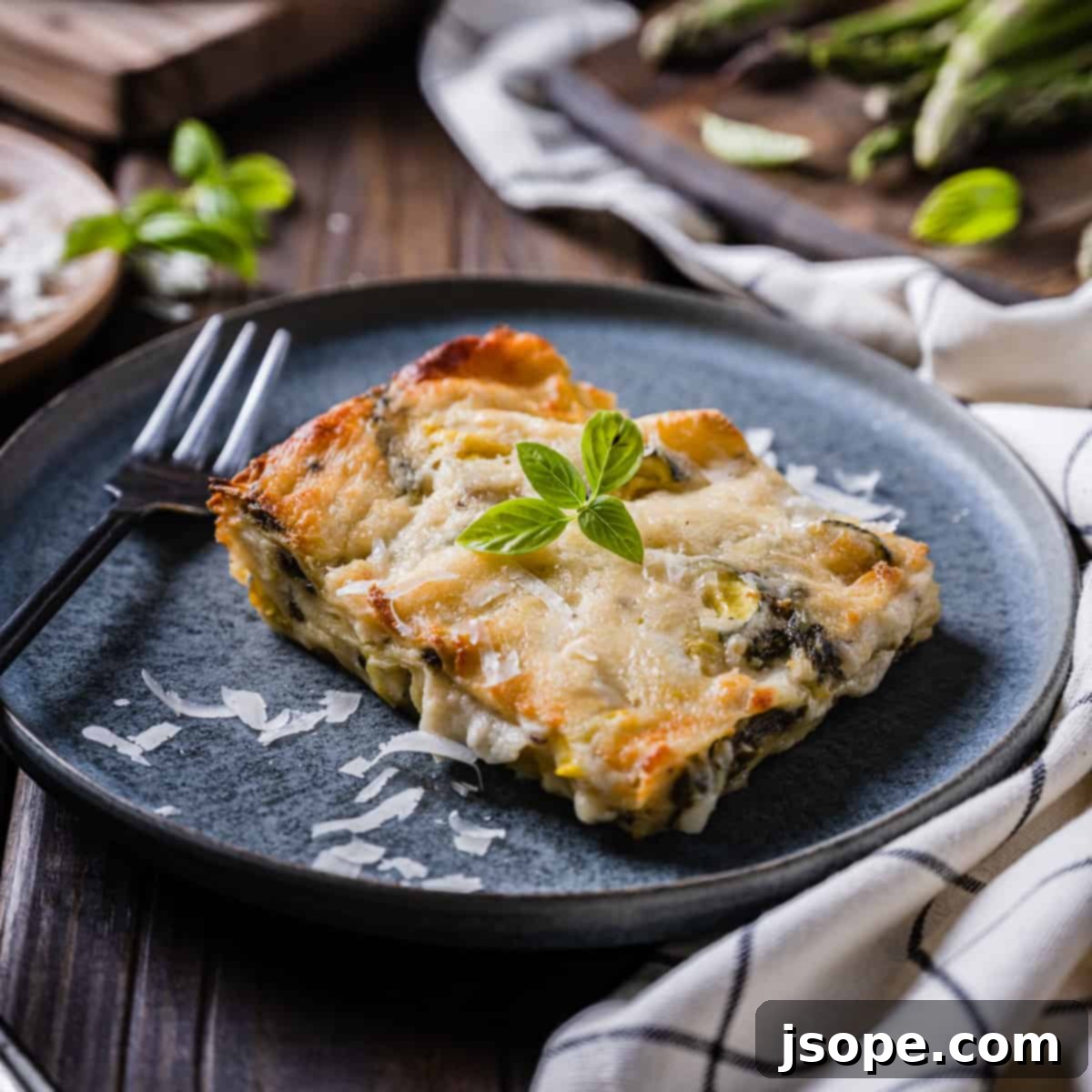Ultimate Vegetable Lasagna with Creamy White Sauce: A Flavorful Vegetarian Delight
Discover the art of creating a truly remarkable Vegetable Lasagna, featuring a luscious white sauce that perfectly complements a vibrant medley of fresh vegetables. This recipe transforms classic lasagna into a wholesome, yet incredibly satisfying meal that’s rich in flavor without being overly heavy. It’s a fantastic way to enjoy a diverse range of seasonal produce, all brought together by a silky béchamel and a harmonious blend of cheeses.

The Heart of the Dish: A Bounty of Fresh Vegetables
This lasagna is generously filled with a delightful combination of artichoke hearts, tender asparagus, delicate zucchini, and sweet yellow squash. We’ve handpicked these vegetables for their complementary textures and flavors, ensuring each bite offers a fresh, vibrant experience. However, the beauty of this dish lies in its adaptability; feel free to substitute or add your favorite vegetables to make it truly your own.
The Art of Pre-Cooking Vegetables for Perfect Lasagna
A crucial step for a flawless lasagna is properly preparing your vegetables. The key is to precook them gently without overcooking. This initial step serves a vital purpose: it helps to release and cook off some of the inherent water content in the vegetables. Failing to do so can lead to a “soupy” lasagna, as excess moisture seeps out during baking, diluting your delicious sauce and making the dish watery.
It’s a delicate balance; you want the vegetables to soften and lose some moisture, but remain firm enough to hold their shape and texture through the final bake. If you cook them until they’re completely tender before assembling the lasagna, they’ll turn mushy and fall apart during their second round of cooking in the oven. Aim for an al dente texture – tender-crisp – that will finish cooking beautifully within the lasagna layers.
You might find it counterintuitive that raw artichoke hearts require a similar precooking time to softer vegetables like yellow squash or asparagus tips. Rest assured, the artichoke pieces will cook perfectly within the lasagna, becoming tender and never hard, adding a wonderful chewiness and earthy flavor to the dish.
Customizing Your Lasagna: Other Vegetable Ideas
While our chosen quartet of artichoke hearts, asparagus, zucchini, and yellow squash creates a fantastic flavor profile, this lasagna is incredibly versatile. Consider adding finely chopped spinach (sautéed to remove excess water), sliced mushrooms (browned for depth of flavor), roasted bell peppers, or thinly sliced eggplant (salted and drained to remove bitterness). For a touch of green, you could even incorporate some kale or Swiss chard. The key is to select vegetables that complement each other and to always remember the importance of precooking to prevent a watery lasagna.

Crafting the Perfect Creamy White Sauce and Selecting Cheeses
The sublime combination of cheeses and a perfectly executed béchamel sauce is what elevates this dish, making it a delightfully flavorful yet remarkably light lasagna. Each component plays a vital role in achieving this exquisite balance.
The Magic of Béchamel: A Culinary Foundation
Our béchamel is a deceptively simple version, relying on the subtle aromatic magic of bay leaf and a whisper of nutmeg to impart its signature flavor. Originating from French cuisine, béchamel is one of the “mother sauces” and serves as a creamy, binding foundation for many dishes, including Italian pasta al forno. To achieve a perfectly smooth and lump-free béchamel, start by melting butter and whisking in flour to create a roux. This roux is then gradually combined with warm milk, whisking continuously until the sauce thickens to a velvety consistency. Patience is key here; cook it over medium-low heat, stirring frequently, to allow the sauce to fully develop its body and flavor without scorching.
The Italian Cheese Duo: Pecorino Romano and Parmigiano Reggiano
The choice of cheeses is paramount for an authentic Italian flavor. Pecorino Romano, a hard, salty sheep’s milk cheese, offers a more pungent and assertive flavor compared to the nutty, slightly milder Parmigiano Reggiano. The combination of these two iconic Italian cheeses in this lasagna creates a complex and deeply satisfying taste profile. It delivers a profound cheesy essence without becoming overly heavy or dominating the delicate vegetable and béchamel flavors. For the best results, always seek out genuine, aged cheeses from Italy. The difference in quality, depth, and character will have an immense, positive effect on your finished dish.
Exploring Other Cheese Variations
While Pecorino Romano and Parmigiano Reggiano form the traditional backbone of this white sauce lasagna, don’t hesitate to experiment with other Italian cheeses. Fresh ricotta cheese can add a creamy, slightly sweet contrast to the savory notes. Layers of thinly sliced mozzarella will provide that coveted stretchy, gooey texture, while a touch of fontina can introduce a mild, buttery richness. Whichever cheeses you choose, ensure they are high quality for the best flavor.
Master the Pasta: Homemade vs. Store-Bought Sheets
The foundation of any great lasagna is its pasta sheets. You have two excellent options: crafting them yourself or using high-quality store-bought varieties.
The Unrivaled Taste of Homemade Pasta
We passionately encourage you to explore the world of homemade pasta, including lasagna sheets. If you’ve never ventured into home pasta making, you’re in for a treat! The texture, freshness, and overall superior quality of homemade pasta are, in our humble opinion, unmatched. For comprehensive instructions and our beloved multipurpose pasta dough recipe, be sure to check out our dedicated Homemade Pasta post. It provides all the intricate details you’ll need to create perfect, tender sheets that will absorb the sauces beautifully.
Choosing and Preparing Store-Bought Lasagna Sheets
While homemade pasta offers an unparalleled experience, this vegetable lasagna is equally delicious and convenient with store-bought dry pasta sheets. When opting for commercial pasta, pay close attention to the package directions. Some varieties, often labeled “no-boil” or “oven-ready,” do not require precooking, absorbing moisture directly from the sauce during baking. Traditional dry sheets, however, usually require par-cooking (boiling for a few minutes) before assembly to ensure they become tender. Cook them about 75% of the way through to prevent them from becoming too soft in the final bake. Always follow the specific instructions on the box to ensure your pasta is prepared correctly for the best possible outcome.
Make-Ahead Lasagna: Convenience Without Compromise
One of the many wonderful attributes of lasagna, in general, is its suitability for advance preparation. This makes it an ideal dish for busy weeknights, entertaining, or simply for meal prepping. You can assemble your vegetable lasagna entirely ahead of time and either refrigerate it for a few days or freeze it for longer storage, ready to bake whenever the craving strikes.
Refrigeration for Future Feasts
If you choose to assemble your lasagna in advance and refrigerate it, the process is incredibly straightforward. Simply cover the assembled lasagna tightly with plastic wrap or foil and place it in the refrigerator for up to 2-3 days. When you’re ready to cook, remove it directly from the fridge and place it straight into a preheated oven. Keep in mind that a chilled lasagna will naturally take a little longer to cook than one assembled immediately. Look for clear signs of doneness: vigorous bubbling around the edges, a golden-brown top layer of cheese, and a robust internal temperature. For absolute certainty, an instant-read thermometer inserted into the center should register 165°F (74°C).
Freezing Lasagna for Long-Term Enjoyment
For even greater convenience, this vegetable lasagna freezes beautifully. Once assembled, wrap the baking dish tightly with multiple layers of plastic wrap and then a layer of aluminum foil to prevent freezer burn. It can be stored in the freezer for up to 2-3 months. When you’re ready to enjoy, you can transfer it directly from the freezer to a preheated oven – no thawing required! However, baking from frozen will necessitate a significantly longer cooking time. We recommend covering the lasagna with foil for the initial 30-45 minutes of baking. This helps to ensure it cooks through evenly and prevents the top from browning too quickly. After this initial period, remove the foil for the final 10-15 minutes (or longer, if needed) to allow the top to become gloriously golden brown and bubbly. As with refrigerated lasagna, a thermometer in the center should read 165°F (74°C) to confirm it’s thoroughly heated.
Assembling and Baking Your Lasagna to Perfection
Preheat your oven to 375°F (190°C) to ensure an even bake. Begin the assembly by lightly coating the bottom and sides of a 9×13-inch baking dish with a tablespoon of olive oil. This prevents sticking and helps create a lovely crust. Next, lay down your first layer of pasta sheets, ensuring they cover the bottom of the dish without too much overlap. Spoon over a generous layer of your creamy vegetable béchamel mixture, spreading it evenly. Repeat these layers of pasta and sauce until your dish is full, making sure the final top layer is a thin spread of the béchamel sauce. Sprinkle with additional Parmigiano or Pecorino cheese, or both, for an extra cheesy top. Bake for 30-45 minutes, or until the edges are bubbling vigorously and the cheese on top is golden brown. A gentle jiggle of the dish should show the center is set, not liquid. Always allow the lasagna to rest for 10-15 minutes after baking before slicing; this allows the layers to set and makes for cleaner, more beautiful servings.
Serving Suggestions and Pairings
This Vegetable Lasagna with White Sauce is a complete meal on its own, but it pairs wonderfully with a crisp green salad dressed with a light vinaigrette. A side of crusty Italian bread is perfect for soaking up any leftover sauce. For wine enthusiasts, a light-bodied white wine such as a Pinot Grigio or a dry Sauvignon Blanc would complement the fresh vegetables and creamy sauce beautifully. For red wine lovers, a light-bodied Italian red like a young Chianti or a Barbera would also be a great choice.
Mangiamo! A Culinary Journey Awaits
“Mangiamo” in Italian simply means “Let’s eat!” More than just a phrase, it embodies the joy and communal spirit of Italian dining. It’s also the proud title of our very own Italian cookbook! This culinary treasure is brimming with 60 of our most cherished Italian and Italian-inspired recipes. We are confident that you will adore exploring its pages and bringing these authentic flavors into your home kitchen. To learn more about this essential addition to any food lover’s collection, discover it HERE.

Enjoy Your Homemade Masterpiece!
We sincerely hope that you savor every forkful of this delightful Vegetable Lasagna with White Sauce. Crafting this recipe brings us immense joy, and sharing it with you is an absolute pleasure. If you decide to give it a try, please take a moment to leave us a 5-star rating and a comment below – your feedback is invaluable to us! Alternatively, we’d love for you to share your culinary creations on Instagram and tag us @cooking_with_wine. Buon appetito!

Looking for more delicious pasta recipes? Explore these favorites:
- Creamy Pesto Pasta with Seared Scallops
- Marsala Mushroom Casarecce Pasta
- Seared Scallop Pasta with Vanilla Grapefruit Cream Sauce
- Baked Rigatoni with Tomato Herb Meat Sauce
📖 Recipe

Vegetable Lasagna with White Sauce
30 mins
30 mins
1 hr
Dinner
Italian
8 servings
519 kcal
Ingredients
For the Lasagne Sheets
- 1 lb dry lasagna sheets, or 1 recipe Multi-Purpose Pasta Dough – rolled into lasagna sheets (*see note)
For the Béchamel Sauce
- 5 cups (1183ml) whole milk
- 2 small bay leaves
- 6 tablespoon (84g) unsalted butter
- ⅔ cup (83g) AP Flour
- 1 teaspoon kosher salt
- ¼ teaspoon nutmeg
- ½ teaspoon black pepper
For the Vegetables
- 2 tablespoon butter
- 1 small zucchini (1 cup) (105g) sliced ¼” thick and halved
- 1 small yellow squash (1 cup) (105g) sliced ¼” thick and halved
- 1 ½ cup asparagus tips and stalks (150g) cut into ¾” pieces
- 1 ½ cups artichoke hearts, cleaned and cut into large dice (*see note)
- 1 teaspoon kosher salt
- ½ cup Pecorino cheese, grated
- ½ cup Parmigiano Reggiano cheese, grated
Other Ingredients
- 1 tablespoon olive oil to coat the bottom of your baking dish
- fresh basil leaves for garnish
- additional Pecorino or Parmigiano Reggiano cheese for serving
Instructions
Make the Sauce
- Warm the milk with the bay leaf in a small saucepan to just under a simmer.
- In another saucepan, melt the butter over medium heat. Add the flour to the butter and whisk constantly to combine without browning the flour.
- Remove the bay leaf from the milk, then gradually add the milk to the butter and flour mixture while whisking until a smooth consistency is reached and there are no lumps. Cook over medium-low heat for 10-15 minutes, whisking or stirring often.
- Finally, add the salt, nutmeg, and pepper and stir to fully incorporate. Taste and adjust salt as necessary.
For the vegetables
- In a large skillet over medium heat, melt the butter. Add the vegetables and salt and gently cook until the vegetables soften but are not mushy – about 5 minutes. Stir the vegetables into the béchamel sauce with the Pecorino and Parmigiano cheeses until thoroughly incorporated.
Assemble the Lasagna
- Preheat your oven to 375°F.
- Assemble your lasagna starting with a thin layer of olive oil on the bottom and sides of a 9×13-inch baking dish. Add a layer of pasta, then sauce/vegetable mixture. Repeat until your dish is full; the top being a thin layer of sauce.
- Sprinkle the top with more Parmigiano or Pecorino (or both) if desired. Place in the oven for 30-45 minutes or until the lasagna is bubbly and the center is hot (an instant read thermometer should read 170°F in the center).
- Once done, allow your lasagna to sit for about 10-15 minutes before cutting into to allow it to cool slightly.
Notes
Nutrition
Carbohydrates: 61 g
Protein: 19 g
Fat: 22 g
Saturated Fat: 13 g
Polyunsaturated Fat: 1 g
Monounsaturated Fat: 6 g
Trans Fat: 0.5 g
Cholesterol: 59 mg
Sodium: 966 mg
Potassium: 477 mg
Fiber: 3 g
Sugar: 10 g
Vitamin A: 796 IU
Vitamin C: 6 mg
Calcium: 353 mg
Iron: 2 mg
classic Italian recipes, Lasagna, pasta al forno, Summer pasta, vegetarian
Tried this recipe?
Let us know how it was!
Do You Love Our Recipes?
We work tirelessly to provide you with delicious, high-quality, and completely FREE recipes here on Cooking With Wine. If you appreciate and value our content, and wish to support our continuous efforts to bring you more culinary inspiration, you are welcome to contribute any amount you feel comfortable with. Your generosity helps us keep this passion project thriving!
Please know that we are fully committed to continuing to provide you with wonderful recipes regardless of contributions. There is absolutely no obligation to contribute, and your continued presence in our community is always the most important thing. However, any and all contributions, no matter how small, are immensely appreciated and go a long way in supporting our work!
Thank you for being an integral part of our vibrant community! You are genuinely the reason we do what we do, and your enthusiasm for food fuels our creativity and dedication.
